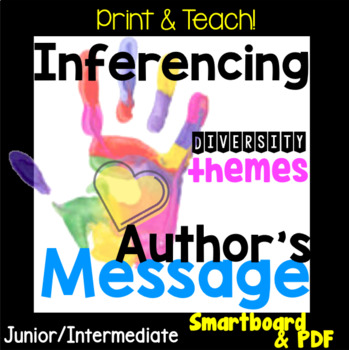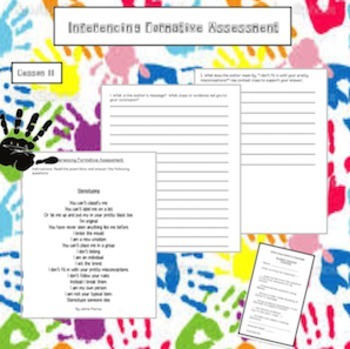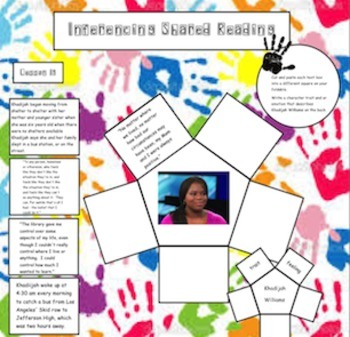NO PREP! Inferencing Author's Message Unit, Diversity, Smartboard & PDF
Launching Learning
238 Followers
Grade Levels
4th - 6th
Subjects
Resource Type
Standards
CCSSRL.4.1
CCSSRL.4.4
CCSSRL.4.10
CCSSRL.5.1
CCSSRL.5.4
Formats Included
- NOTEBOOK (SMARTboard) File
Pages
100+
Launching Learning
238 Followers
Description
UPDATED: *Clarity has been fixed on this unit!* I also added name/date headers to handouts and links to each handout on SB lesson page for easy access*
------------------------------------------------------------------------------------------
ABOUT THE UNIT:
Teach and challenge your students to use inferencing skills! This is a reading for meaning unit where students learn the basics of inferencing and are challenged to infer the author’s message of a variety of high interest texts. The common thread of all the texts in the unit is DIVERSITY.
This is a NO PREP unit, simply print and teach. Everything you need is here!
This purchase includes:
> Smartboard File, includes 14 lessons (59 pages) and links to a variety of videos.
> PDF file, (68 pages) linked on Smartboard file, contains all handouts needed for the unit.
> All texts included that share a common theme of diversity (race, gender, ability, and status)
There are a variety of texts such as music lyrics, videos, short stories, biographies, and
poems.
> All assessments included: diagnostic, formative and summative.
> Teacher rubric and student checklist
> Unit Plans, at the end of PDF file
Lessons:
Starter Homework Activity: Inferencing Bags
Home Note: send note early for students to bring items for artifact bags. Bags are to be returned to begin the unit.
Diagnostic Assessment: Michael Jackson’s “Man In the Mirror” Music video, lyrics and response questions.
Lesson 1: What Is Inferencing?
> What Is Inferencing? Students look at 4 examples of items that were in an artifact bag (pictures) As a group, discuss what inferences we can make about these people based on the items in the bag. * As a bonus the teacher can make up his/her own inference bag. This could be with items that relate to you or someone in the school (another teacher, principal etc)
> Artefact Bags, small group activity. Students pull items from the bag and make inferences about who the bag belongs to.
Lesson #2: Inferencing Body Language
> Tell students that we make inferences everyday, even when we don’t realize we’re doing it. An example of this is reading peoples body language. Show them 4 picture examples. Students disuse what inferences they can make based on body language.
> Inferencing Charades, student pick an emotion from a hat and act it out using no words or sounds. Class guesses which emotion they are trying to convey through their body language.
Lesson #3: Schema
> How We Inference: students learn about how their “schema” helps them make inferences.
> Schema Roller: students think of their schema like a lint roller that al their experiences and knowledge sticks to. They make inferences given 2 different words “right” and “equality” students share what they know about those words and teacher recode the brainstorm.
> Stick It Activity. Students rotate around the room in small groups viewing a selection of images. Students are given sticky notes to post beside the images. On the sticky notes they record and inferences that they have about the image.
Lesson 4: Practicing Inferencing
> Modelled Inference. The students are shown a picture. (Picture relates to gender stereotypes of women when searching “woman” on google) Teacher models how he/she would make inferences about the picture and explain the evidence used to make the inference.
> Students independently write an inference response given a picture (Disabled boy photo).
Lesson #5: Context Clues
> Context clues video
> Students discuss what the word “rupture” means, and what context clues they used to determine the meaning of the word.
> Context clues partner practice. Students practice determining the meaning of unknown words (multiple choice).
> Independent practice, students complete the “Define the Word” activity.
Lesson 6: Inferencing Place Mat
> Students watch the Music Video Ugly (about a visual minority girl)
> In groups of 4 give students the lyrics to the song, each group member write down (in their section of the placemat) what they infer about the person singing the song. Students share with group members when complete. All groups return and share their inferences with the class.
Lesson 7: Inferring CharacterTraits
> What are character Traits, how we infer character traits
> Video, Nick Vujicic (Disabled motivational speaker), students discuss what character traits might describe his character.
> Character Traits Activity, students cut a hole in a late piece of paper to put their face through. Around the whole they write character traits that describe them. (optional, teacher takes pictures and posts on bulletin)
Lesson 8: Inferring Character FAST
> Students learn an acronym FAST that can help them infer character traits. (Feel, act, say, think)
> Shared Reading, Jeremy Sicile-Kira (about a disabled boy who finishes high school), class reads together and uses FAST to determine character traits that describe Jeremy.
> In partners, students fill in graphic organizer. Students are given the character traits inferences and have to find the evidence in the text to back it up.
> Partner Reading, partners take furs reading “I Hope You Dance” short story. Using FAST, students fill in graphic organizer with partner making infernos about the character and providing evidence.
> HOMEWORK assignment, reading “The Challenge I Overcame”. Students complete reading and graphic organizer independently for homework.
Lesson 9: Author’s Message
> What is author’s message, brainstorm
> Video, The Tree (no words just music and action, about working together for a common goal)
Students discuss what they think is the message of the video and what clues they saw in the video that lead them to this inference.
> Shared Reading, Michael Jackson’s, “Man In the Mirror”, students watch the video again and read the lyrics.
> Students write what they think the author’s message is on a whiteboard and share with a shoulder partner.
> Independent writing: students watch the “X-rayVideo”. After watching the video students write a response about the author’s message.
Lesson 10: Student Moderation, X-ray Video
> Re-watch the “X-ray Video” (about diversity in all its forms and acceptance)
> In small groups students are given 4 sample responses to X-ray video. Students decide with their group members what level they would give each pier of writing. Groups will discuss positives and areas of improvement for each piece of writing also. After all groups have finished, the whole class will meet to share their levels.
> As a class create the success criteria for a level 4 inference response. Students list all the key elements that are in an excellent detailed response. Teacher records on anchor chart. (This becomes the student checklist)
Lesson 11: Inferencing Shared Reading
> Packages getting started activity. Given a variety of pictures students choose a package. Teacher slides the package over to reveal what’s inside.
Students learn that appearances may be deceiving!
> Inferencing Shared Reading: students watch video “Stereotypes and Prejudice” and with a partner answer 2 response questions (inferring the meaning of the word stereotype and author’s message of the video)
> FORMATIVE, poem “Stereotypes”, students complete response individually.
Lesson 12: Inferencing Shared Reading, visual poem “Mankind Is No Island”.
Students watch visual poem, “Mankind is no Island” (about the homeless) keeping author’s message in mind.
> Milling to Music, students mill around the room to music. When music stops, they answer a discussion question with a nearby classmate.
> Character traits and feelings: students learn the difference between character traits and feelings. Teacher can model and then open up to students to identify feeling and character traits in a given image (people helping a homeless man).
> In partners, students examine another image (young teen helping an elderly lady) and discuss feelings and character traits that relate to the people in the picture.
Lesson 13: Inferring Character
> Video, Oprah’s Life Class, “Khadijah’s Journey”
> Shared Reading, short biography, “Khadijah’s Journey: Skid Row to Harvard”
> 5 Pedal Foldable, given the evidence students determine a character trait that describes the quote from the text. Cut and glue into foldable.
Lesson #14: Inferring Character Traits
> Students select a text from a variety of choices (Outstanding Kids).
> After reading article students fill in graphic organizer to describe the character traits of the child based on his/her F- feelings, A- actions, S- what he/she says, and T- his/her thoughts.
Summative Assessment
> Students read the text “Back on the Board” (story about disabled surfer)
* Covers Ontario and U.S Common Core Curriculum Expectations*
------------------------------------------------------------------------------------------
ABOUT THE UNIT:
Teach and challenge your students to use inferencing skills! This is a reading for meaning unit where students learn the basics of inferencing and are challenged to infer the author’s message of a variety of high interest texts. The common thread of all the texts in the unit is DIVERSITY.
This is a NO PREP unit, simply print and teach. Everything you need is here!
This purchase includes:
> Smartboard File, includes 14 lessons (59 pages) and links to a variety of videos.
> PDF file, (68 pages) linked on Smartboard file, contains all handouts needed for the unit.
> All texts included that share a common theme of diversity (race, gender, ability, and status)
There are a variety of texts such as music lyrics, videos, short stories, biographies, and
poems.
> All assessments included: diagnostic, formative and summative.
> Teacher rubric and student checklist
> Unit Plans, at the end of PDF file
Lessons:
Starter Homework Activity: Inferencing Bags
Home Note: send note early for students to bring items for artifact bags. Bags are to be returned to begin the unit.
Diagnostic Assessment: Michael Jackson’s “Man In the Mirror” Music video, lyrics and response questions.
Lesson 1: What Is Inferencing?
> What Is Inferencing? Students look at 4 examples of items that were in an artifact bag (pictures) As a group, discuss what inferences we can make about these people based on the items in the bag. * As a bonus the teacher can make up his/her own inference bag. This could be with items that relate to you or someone in the school (another teacher, principal etc)
> Artefact Bags, small group activity. Students pull items from the bag and make inferences about who the bag belongs to.
Lesson #2: Inferencing Body Language
> Tell students that we make inferences everyday, even when we don’t realize we’re doing it. An example of this is reading peoples body language. Show them 4 picture examples. Students disuse what inferences they can make based on body language.
> Inferencing Charades, student pick an emotion from a hat and act it out using no words or sounds. Class guesses which emotion they are trying to convey through their body language.
Lesson #3: Schema
> How We Inference: students learn about how their “schema” helps them make inferences.
> Schema Roller: students think of their schema like a lint roller that al their experiences and knowledge sticks to. They make inferences given 2 different words “right” and “equality” students share what they know about those words and teacher recode the brainstorm.
> Stick It Activity. Students rotate around the room in small groups viewing a selection of images. Students are given sticky notes to post beside the images. On the sticky notes they record and inferences that they have about the image.
Lesson 4: Practicing Inferencing
> Modelled Inference. The students are shown a picture. (Picture relates to gender stereotypes of women when searching “woman” on google) Teacher models how he/she would make inferences about the picture and explain the evidence used to make the inference.
> Students independently write an inference response given a picture (Disabled boy photo).
Lesson #5: Context Clues
> Context clues video
> Students discuss what the word “rupture” means, and what context clues they used to determine the meaning of the word.
> Context clues partner practice. Students practice determining the meaning of unknown words (multiple choice).
> Independent practice, students complete the “Define the Word” activity.
Lesson 6: Inferencing Place Mat
> Students watch the Music Video Ugly (about a visual minority girl)
> In groups of 4 give students the lyrics to the song, each group member write down (in their section of the placemat) what they infer about the person singing the song. Students share with group members when complete. All groups return and share their inferences with the class.
Lesson 7: Inferring CharacterTraits
> What are character Traits, how we infer character traits
> Video, Nick Vujicic (Disabled motivational speaker), students discuss what character traits might describe his character.
> Character Traits Activity, students cut a hole in a late piece of paper to put their face through. Around the whole they write character traits that describe them. (optional, teacher takes pictures and posts on bulletin)
Lesson 8: Inferring Character FAST
> Students learn an acronym FAST that can help them infer character traits. (Feel, act, say, think)
> Shared Reading, Jeremy Sicile-Kira (about a disabled boy who finishes high school), class reads together and uses FAST to determine character traits that describe Jeremy.
> In partners, students fill in graphic organizer. Students are given the character traits inferences and have to find the evidence in the text to back it up.
> Partner Reading, partners take furs reading “I Hope You Dance” short story. Using FAST, students fill in graphic organizer with partner making infernos about the character and providing evidence.
> HOMEWORK assignment, reading “The Challenge I Overcame”. Students complete reading and graphic organizer independently for homework.
Lesson 9: Author’s Message
> What is author’s message, brainstorm
> Video, The Tree (no words just music and action, about working together for a common goal)
Students discuss what they think is the message of the video and what clues they saw in the video that lead them to this inference.
> Shared Reading, Michael Jackson’s, “Man In the Mirror”, students watch the video again and read the lyrics.
> Students write what they think the author’s message is on a whiteboard and share with a shoulder partner.
> Independent writing: students watch the “X-rayVideo”. After watching the video students write a response about the author’s message.
Lesson 10: Student Moderation, X-ray Video
> Re-watch the “X-ray Video” (about diversity in all its forms and acceptance)
> In small groups students are given 4 sample responses to X-ray video. Students decide with their group members what level they would give each pier of writing. Groups will discuss positives and areas of improvement for each piece of writing also. After all groups have finished, the whole class will meet to share their levels.
> As a class create the success criteria for a level 4 inference response. Students list all the key elements that are in an excellent detailed response. Teacher records on anchor chart. (This becomes the student checklist)
Lesson 11: Inferencing Shared Reading
> Packages getting started activity. Given a variety of pictures students choose a package. Teacher slides the package over to reveal what’s inside.
Students learn that appearances may be deceiving!
> Inferencing Shared Reading: students watch video “Stereotypes and Prejudice” and with a partner answer 2 response questions (inferring the meaning of the word stereotype and author’s message of the video)
> FORMATIVE, poem “Stereotypes”, students complete response individually.
Lesson 12: Inferencing Shared Reading, visual poem “Mankind Is No Island”.
Students watch visual poem, “Mankind is no Island” (about the homeless) keeping author’s message in mind.
> Milling to Music, students mill around the room to music. When music stops, they answer a discussion question with a nearby classmate.
> Character traits and feelings: students learn the difference between character traits and feelings. Teacher can model and then open up to students to identify feeling and character traits in a given image (people helping a homeless man).
> In partners, students examine another image (young teen helping an elderly lady) and discuss feelings and character traits that relate to the people in the picture.
Lesson 13: Inferring Character
> Video, Oprah’s Life Class, “Khadijah’s Journey”
> Shared Reading, short biography, “Khadijah’s Journey: Skid Row to Harvard”
> 5 Pedal Foldable, given the evidence students determine a character trait that describes the quote from the text. Cut and glue into foldable.
Lesson #14: Inferring Character Traits
> Students select a text from a variety of choices (Outstanding Kids).
> After reading article students fill in graphic organizer to describe the character traits of the child based on his/her F- feelings, A- actions, S- what he/she says, and T- his/her thoughts.
Summative Assessment
> Students read the text “Back on the Board” (story about disabled surfer)
* Covers Ontario and U.S Common Core Curriculum Expectations*
Total Pages
100+
Answer Key
N/A
Teaching Duration
2 Weeks
Report this resource to TPT
Reported resources will be reviewed by our team. Report this resource to let us know if this resource violates TPT’s content guidelines.
Standards
to see state-specific standards (only available in the US).
CCSSRL.4.1
Refer to details and examples in a text when explaining what the text says explicitly and when drawing inferences from the text.
CCSSRL.4.4
Determine the meaning of words and phrases as they are used in a text, including those that allude to significant characters found in mythology (e.g., Herculean).
CCSSRL.4.10
By the end of the year, read and comprehend literature, including stories, dramas, and poetry, in the grades 4–5 text complexity band proficiently, with scaffolding as needed at the high end of the range.
CCSSRL.5.1
Quote accurately from a text when explaining what the text says explicitly and when drawing inferences from the text.
CCSSRL.5.4
Determine the meaning of words and phrases as they are used in a text, including figurative language such as metaphors and similes.





